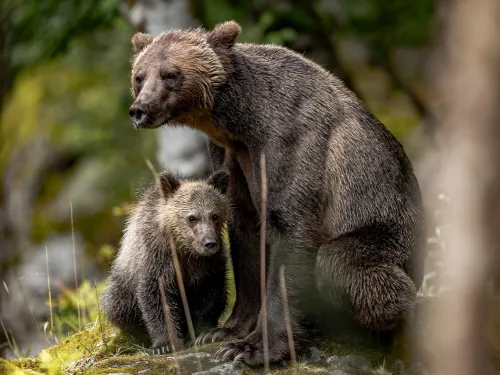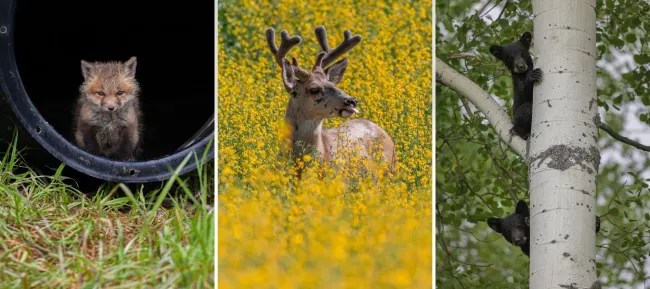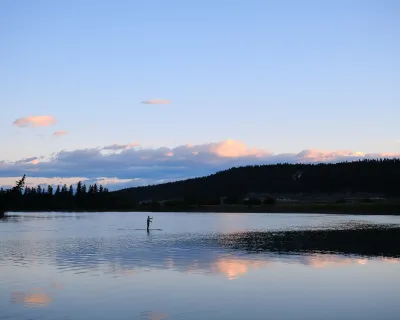The meanest moms in the west mean well
When you sense danger do you stand and fight or flee? While each species has its instinct to do one or the other, mothers across almost every species are the same. They will shred a threat or predator to pieces to protect their young.
While we all know it’s hazardous to get between a momma grizzly and her cubs, there are a few other moms in our western wilderness that should also be shown respect.
A “goose” on the butt is nasty from a Canada Goose
Those fuzzy goslings you see near waterbodies are cuties but their mothers are not. Both the male and the female are very protective of their territory during the nesting and early days after the hatch. If you were taking care of two to nine of your own babies or the whole nursey, you’d be a bit flighty too.
If you see a goose hissing, bobbing its head or flapping its wings at you and it is still at a distance away, don’t run away screaming – that just makes it worse. Keep eye contact and increase the zone between you and the angry mom by moving sideways out of her territory.
Some naturalists suggest while keeping that very important eye contact and lateral movement, point at it to appear like a big goose. A poke by that beak really hurts.
Do you know how to tell the difference between male and female Canada Geese? The males are larger and they honk. The ladies have a shorter shrill or “hrink”.
A mama elk will rough you up
While elk usually travel in herds, when it comes time to give birth, a female elk will wander away from the group to focus on her offspring. An elk calf arrives weighing between 14 and 16 kilograms and can stand on its own after just twenty minutes.
However, it is very vulnerable to predators. So the first few weeks are spent tucked in the trees before returning to the herd. Elk calves are like deer and are born with spots that replicate the dabble of sun coming through the trees.
find YOUR zen
Sign up for ZenSeekers enews for local culture & outdoor adventure across Western Canada.
The mother just spent the last 240 days pregnant and is not about to have you walk in and mess things up. If you happen upon a lone calf, don’t assume it was abandoned. Leave it quickly because the mom will thunder in and aggressively defend it.
If you see a female elk stare directly at you with flattened ears, raised rump hair and curled lips she is 200 kilos of anger.
Take Parks Canada’s advice on elk safety:
- don’t lose eye contact but move away
- raise your arms and flap a jacket to appear larger
- if she charges, hide behind a tree or a car
- if she makes contact and you fall over, get up and move away. This is not the time to play dead.
Duck! No…I mean Hawk!
Hawks like the Swainson’s hawk tend to mind their own business, chasing down small rodents and insects until its nesting season and then they are fearlessly territorial. They will swoop at you from behind and smack you on the back of the head with enough force to send you to your knees.
I know of a cyclist who has punctures in her helmet from the talons of a hawk. If you find a fledgling on the ground, leave it alone and leave the area. The mother will dive-bomb to protect it.
Don’t mess with a momma bear
The go-to authority on bear behavior for decades has been Dr. Stephen Herrero of the University of Calgary, and he makes some very interesting observations.
While it’s never a good idea to mess with a bear, a black bear mother who keeps her young by her side for at least two years, will choose to bluff-charge and snort at—but not attack—a human.
A grizzly however, keeps her cubs around longer and will aggressively defend them. According to Bear.org, 70% of human deaths caused by grizzly encounters are related to the mother protecting her offspring.
Parks Canada is an excellent source to learn what to do when you meet a bear. Please take time to read their information here.
The first and most important piece of advice is to always travel in a pack and make noise out on the trail. A bear would rather avoid you than encounter you.
Mom is probably watching you
If you think you have found an abandoned wild animal, don’t be the hero, because in many cases you are disrupting what is really going on.
Often the mother is hiding out of sight, waiting either for you to leave or to pounce on you.
Unless there is clear signs of injury or sickness, it is best to call the local wildlife rehabilitation centre or the closest SPCA. They will either tell you what to do or handle the situation properly.
Bottom line: staying safe in the wild means minding the mamas out there. They are worthy of your respect.
Go on an adventure with Mom
Like the wildlife mamas in this story, our mothers care and provide for us, but they can also be amazing adventure partners. Read on and find info and inspiration for your next adventure with mom.











